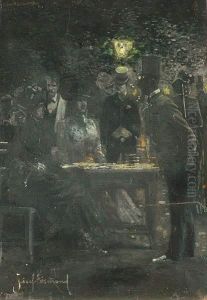Jozef Ejsmond Paintings
Jozef Ejsmond was a Polish artist, predominantly known for his contributions as a painter, graphic artist, and illustrator. Born on October 17, 1870, in Warsaw, Poland, Ejsmond was active during a time of significant cultural and political changes in his country, which was then part of the Russian Empire.
Ejsmond received his artistic education at the Warsaw School of Drawing, which was later renamed the Warsaw School of Fine Arts. He continued his studies abroad, which was a common practice among Polish artists of the time who sought to gain a broader perspective on artistic trends and techniques. He spent time in Munich and Paris, which were key art centers in Europe, absorbing the influences of various art movements, including Impressionism and Symbolism.
His work was characterized by a strong sense of national identity, as he often depicted scenes of Polish history and folklore. Ejsmond was also known for his portraits and landscapes, which showcased his skill in capturing the mood and atmosphere of a subject or scene. He was particularly adept at using light and color to evoke emotion, which is evident in his nuanced paintings of the Polish countryside.
During his career, Ejsmond also contributed to the world of illustration, providing artworks for books and periodicals. His graphic works, which include etchings and lithographs, demonstrate a keen eye for detail and a dedication to craftsmanship.
Jozef Ejsmond's legacy is preserved in the collections of various Polish museums and galleries, as well as in the cultural memory as an artist who played a role in shaping the visual narrative of Poland's national identity. He passed away on August 20, 1946, leaving behind a body of work that continues to be appreciated for its historical significance and artistic merit.
